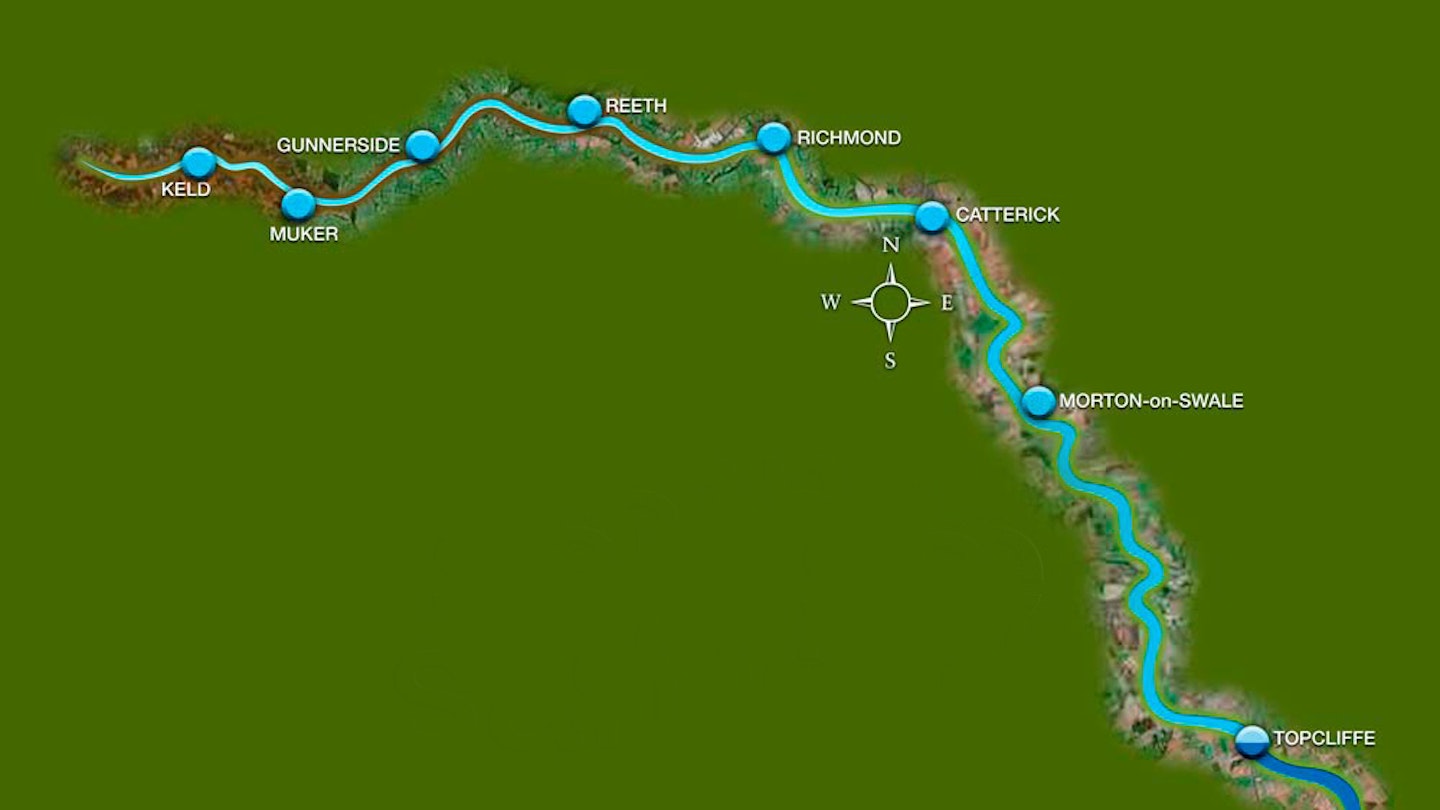If you’re up for the challenge of tackling the wild River Swale the good news is it won’t cost you a fortune.
Lots of stretches are available on cheap annual club permits or day tickets controlled by farmers or locally-based fishing clubs. You can often fish for around £5 a day or £40 a year – bargain!
Like many wild rivers the Swale isn’t evenly stocked with barbel throughout its 72 miles – in the upper reaches near its moorland headwaters the river is narrow and very fast.
According to Jeff and fishing partner Tom Brodrick from Bedale, a man who has walked 100 miles of river during a six-month project to map all of Leeds DASA club waters, the area around Easby Abbey near Richmond marks the point where the barbel population gets a foothold.
In these upper areas of the river you’ll not find huge stocks of barbel but they are there in pockets and local knowledge on where to find them is a vital short-cut to success.
Moving downstream, various clubs control stretches at Catterick, Northallerton, Gatenby, Maunby, Holme and Skipton-on-Swale where you can find groups of barbel.
Don’t forget the Swale is not just a barbel river though – it holds a good stock of chub and 5lb and even 6lb-plus specimens have become a realistic target in the last few years. These upper stretches of river are also good for pike and grayling.
But the start of ‘barbel country’ on the Swale – where large numbers of fish are in residence – can really be said to be the water below Topcliffe weir.
The fast oxygenated water below the weir is home to a small population of fish but as you move to the bottom of the stretch the numbers of barbel increases.
Below Topcliffe is the main area both Jeff and Tom concentrate on. Stretches at Asenby, Cundall Lodge Farm, Cundall Hall, Fawdington, Thornton, Helperby and Myton are some of the best areas for barbel sport.
The good news is these stretches are also home to plenty of chub and you don’t need to feeder fish or leger for them – there are numerous spots offering excellent float trotting water.
As Jeff was keen to point out during our session, it is best to put tales of giant barbel out of your mind when visiting the Swale or any of the other North Yorkshire barbel rivers (see our guide to the rest of the The Big 6, below).
An average sized fish for these rivers is 4lb-5lb with a specimen being anything above 7lb. Double-figure fish are rare but they do exist in numbers that are worth fishing for and while the ‘official’ river record is 14lb 4oz we understand that a 16-pounder has been banked several times from the Swale, a truly massive fish that hints at the potential of the river.
The list of clubs we’ve provided is not exhaustive. Lots of small clubs control short stretches along the river and some of them offer very cheap membership or day tickets. There are also a few private syndicates or ‘closed shop’ clubs that only give membership to anglers living locally.
Nevertheless, our list details some of the biggest water owners on the Swale and all these clubs don’t cost much to join. Their websites carry details of the waters they control.
In addition to stretches on the Swale these organisations also control water on other major North Yorkshire rivers.

NORTH YORKSHIRE’S BIG 6
The Swale is not the only river in North Yorkshire worth fishing. The Wharfe, Ouse, Ure, Nidd and Derwent all hold barbel so here’s our snap-shot guide to these rivers:
The Wharfe: One of the most prolific Yorkshire rivers with plenty of fish residing in Easedike, Linton, Boston Spa, Newton Kyme and Ulleskelf. The barbel tend to be smaller in the Wharfe than the Swale but there are plenty of them.
The Nidd: One of the smaller Yorkshire rivers, the barbel potential of the Nidd is still being explored and according to Tom some of the best stretches in the lower reaches are almost unfished during the summer.
“Take a machete to hack your way to the water!” was his invaluable advice. The lower reaches near to its confluence with the Ouse at Nun Monkton are the best areas. Jeff’s best Nidd barbel is an 8lb 5oz fish taken at Tockwith, near York.
The Ouse: This is something of a melting pot as most of North Yorkshire’s rivers eventually end up in the Ouse one way or another. Linton Lock, Linton On Ouse, Newton, Nun Monkton and Moor Monkton are all stretches worth targeting although there are not huge numbers of barbel to go for. Jeff’s best off the Ouse is 10lb 2oz, which shows what can be caught there.
The Ure: Not as prolific for barbel as the Swale, the Ure is also not as wild and is a slower flowing waterway.
The areas around Ripon, Boroughbridge, Aldwark, Dunsforth and Newby Hall are worth a visit for barbel.
The Derwent: By their own admission Jeff and Tom don’t possess great knowledge of this river but it does have a reputation for holding small groups of barbel that take some finding. If you are feeling brave (or daft!) this is the place to go pioneering for barbel
Fishing clubs to investigate:
Here’s a list of major fishing clubs that control water on the Swale and the other main North Yorkshire rivers.
Membership is cheap, open to all and gives you access to an awful lot of river. Several of these clubs also control good stillwaters. Many clubs in the region sell their annual permits through local tackle shops so you can pick them up when you visit.
Contacts:
Leeds and District Amalgated Society of Anglers (Leeds DASA): www.leedsdasa.co.uk
Bradford No.1 Angling Association: www.bradfordno1.com
Bradford City Angling Association: www.bradfordcityaa.co.uk
York & District Amalgamation of Anglers: www.ydaa.org.uk
